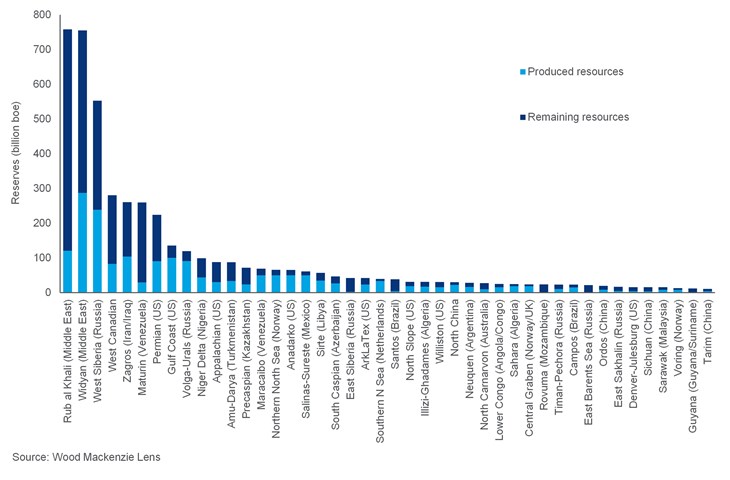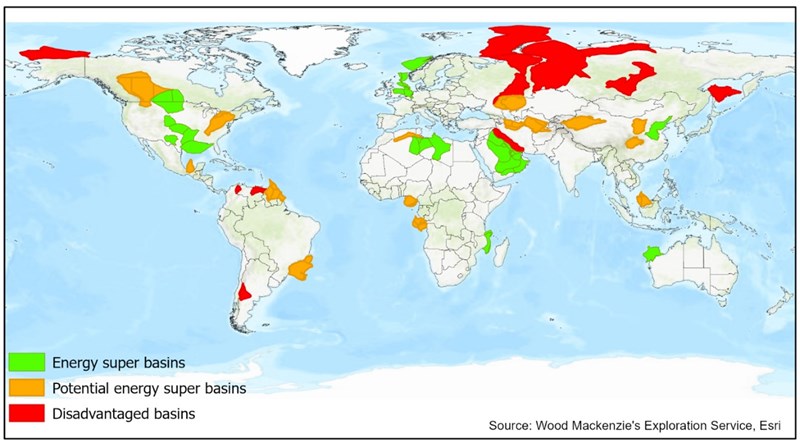Get in touch
-
Mark Thomtonmark.thomton@woodmac.com
+1 630 881 6885 -
Hla Myat Monhla.myatmon@woodmac.com
+65 8533 8860 -
Chris Bobachris.boba@woodmac.com
+44 7408 841129 -
Angélica Juárezangelica.juarez@woodmac.com
+5256 4171 1980 -
BIG PartnershipWoodMac@BigPartnership.co.uk
UK-based PR agency
Half of traditional super basins are future-fit and they have three things in common
3 minute read
Energy super basins of the future must fulfill three key criteria - abundant resources, access to low-cost renewables and hub-scale carbon capture and storage (CCS) opportunities, according to a new report by Wood Mackenzie, a Verisk business (Nasdaq:VRSK).
The world’s need for sustainable energy is set to change the geography of the oil and gas industry, increasingly entwining it with renewables. Therefore, the upstream industry of the 2030s and beyond, must focus on where its synergies with new energies are strongest.
Fewer than 50 traditional super basins supply more than 90% of the world’s oil and gas. These are defined as basins originally holding more than 10 billion boe resources, of which more than 5 billion boe remains.
Wood Mackenzie vice president Andrew Latham said: “Of the remaining resources from traditional super basins, only 1,453 billion boe or half have been identified as future-fit energy super basins defined as having abundant resources, access to low-cost renewables and hub-scale CCS opportunities.
“The upstream industry of the 2030s will have a different footprint as investment migrates to the new energy super basins. With some basins set to be left behind, the industry will become even more concentrated in its top basins. At the same time, upstream strategies will increasingly merge with low-carbon businesses.”
Decarbonising the upstream is the industry’s most pressing sustainability task. Much of the world’s production is operated by companies with net zero targets for Scope 1 and 2 emissions by 2050 or earlier. Electrifying operations using a clean, renewable energy source is one of the fastest and best ways to eliminate emissions. While it is easy to install in new fields and retrofitting old fields could be considered, renewable energy sources need to be plentiful and affordable.
Latham said “The co-location of low-cost renewables with low-cost oil and gas is key. Surplus renewables can also be fed into the grid as part of the overall energy system.”
Scope 3 emissions are the elephant in the room. They accounted for more than 90% of oil and gas’ emissions of 18.5 billion tonnes per annum (Btpa) CO2e in 2021, representing over half of the world’s total energy-related emissions.
Scope 3 emissions can be reduced directly by cutting production or indirectly via sequestration or offsets, and CCS is the most promising sequestration technology. It offers the scale to decarbonise difficult-to-abate consumer sectors and could save 18% (with direct air capture) of annual global emissions by 2050. CCS does not need to be in the same basin as oil and gas production, but in practice is unlikely to be located away from upstream operations.
All existing, planned and hypothetical CCS projects add up to just under 1 Btpa CO2e total capacity. These are concentrated in a handful of countries, largely reflecting the location of commercially feasible CO2 point sources rather than the limited availability of subsurface storage resource.
Latham said: “We expect global CCS capacity to grow to between 2 Btpa and 6 Btpa by 2050. Exactly how and where this will happen is unclear. Our assumption here is that this growth will come mainly from countries that will have hub-scale emissions sources available close to subsurface storage options. CCS operators will offer sequestration as a service to emitters.”
Wood Mackenzie has created a simple scorecard approach using clean electricity and CCS indices identifying basins best placed to make the transition. Some are obvious candidates, scoring highly on all criteria. Others look much less attractive.
Some good examples of future energy super basins include the Gulf Coast and Permian in the US, the Rub al Khali in the Middle East, the North Sea, and Australia’s North Carnarvon. However, more work needs to be done as half of the world’s remaining resources in traditional super basins are disadvantaged.
Energy Super Basins map
Source: Wood Mackenzie Lens Upstream and Lens Power. Top Energy Super Basins feature strong renewables and CCS potential. Possible Energy Super Basins offer good renewables or CCS potential, but probably not both. Disadvantaged super basins lack strong renewables and CCS potential.
The US Gulf Coast and Permian basins are both energy super basins. Both offer plentiful clean electricity from excellent solar power potential and additional renewables from wind. Wood Mackenzie expects a substantial CCS industry to emerge, based on hub-scale CO2 sources from refining, petrochemical and other industrial facilities around the Texas coast.
Latham said: “These scores are not set in stone. Plenty of basins currently sit somewhere in between energy super basins and disadvantaged basins. Host governments may have opportunities to improve the outlook of a basin. Carbon taxes and other fiscal and regulatory moves to accelerate decarbonisation – especially where they enable CCS – could play an important role and should be seized where possible.
“Recognising the long-term direction of travel presents an urgent call to action. It will take many years, even decades, to fundamentally realign global upstream portfolios with the new energy super basins. First-mover advantage applies. The sooner the transition starts, the better.”







